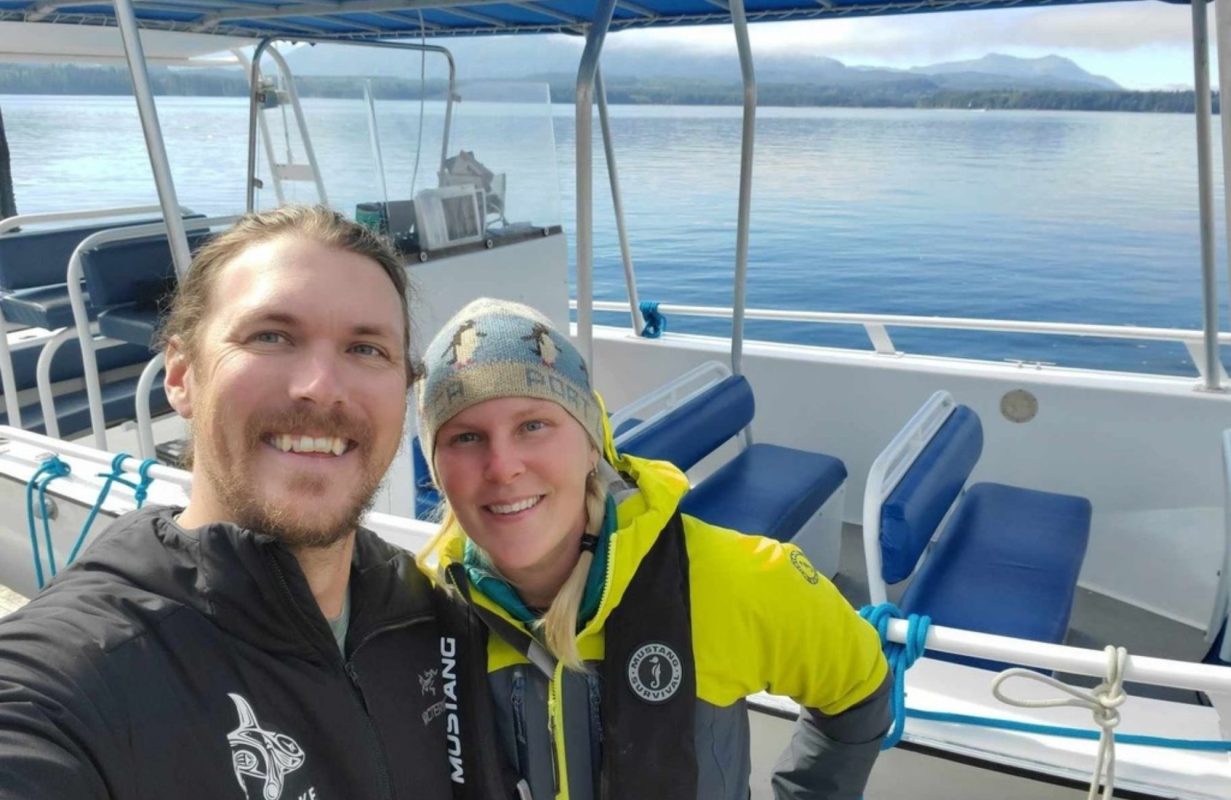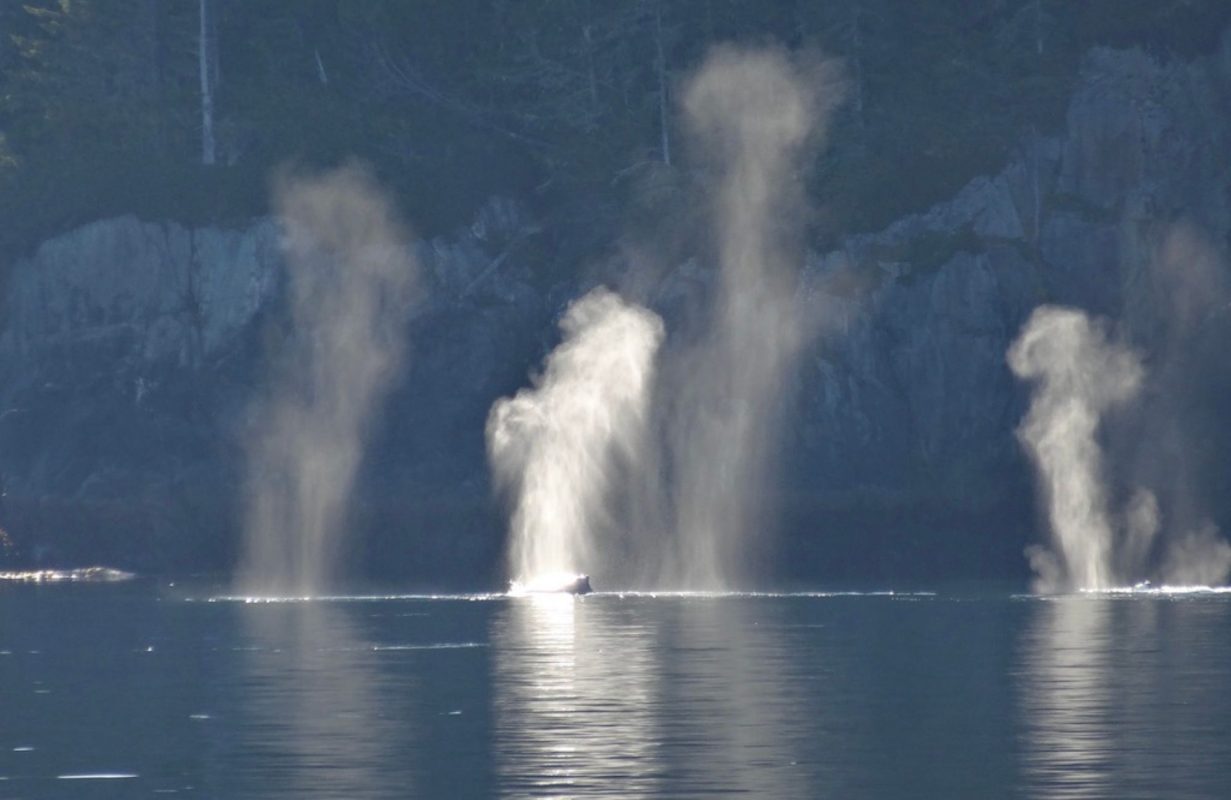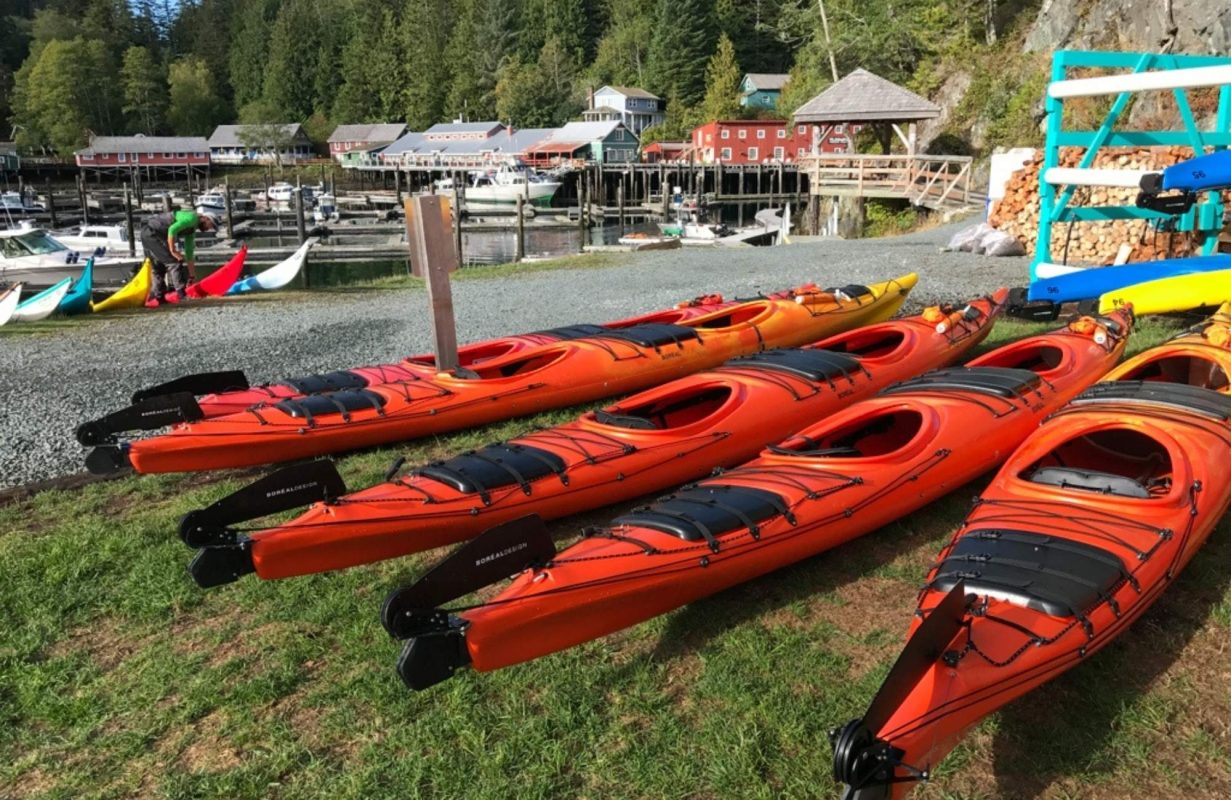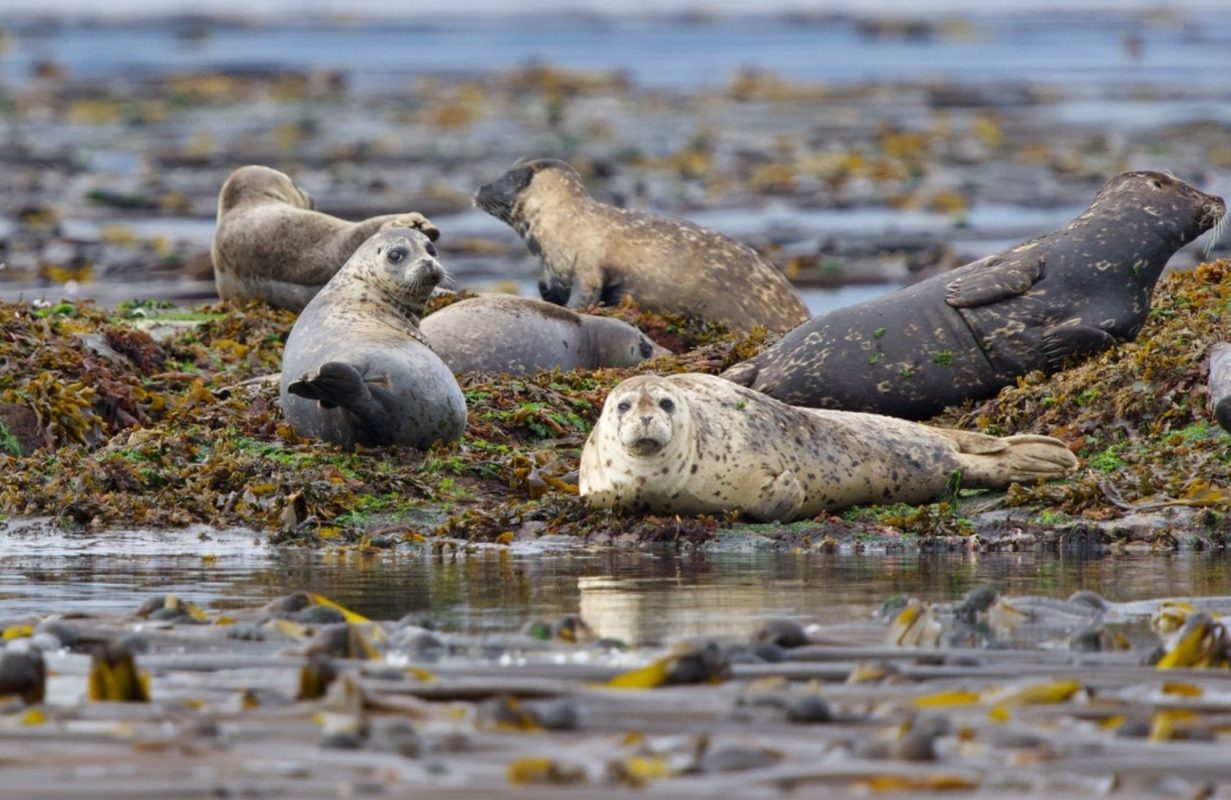If you love marine wildlife, the coast of Northern Vancouver Island is a memorable place in Canada to see it up close. In this article, Carol Patterson shares her experience spotting humpbacks, killer whales, sea otters, and more in the wild—all while making sure it’s done ethically and responsibly.

I focused my long lens on the barnacle-covered whale snout piercing the cold waters of Johnstone Strait, seabirds snatching fish before the humpback could. I’d travelled three days to reach one of Canada’s best wildlife viewing destinations, and I was rapidly learning why this ecosystem was worth watching.
Zooming in for another shot, I watched the humpback whale get smaller in my viewfinder as the boat turned away from the whale. Seasmoke Whale Watching co-owner and captain Jeannine McCormack explained we needed to avoid disturbing it because there are national Marine Mammal Regulations to protect marine mammals from disturbance, including minimum avoidance distances for motorized and self-propelled watercraft. The North Island Marine Mammal Stewardship Association also sets voluntary guidelines on how far marine wildlife tour operators must stay away from whales, but Seasmoke co-owners Jeannine McCormack and Nate Small sometimes stay even further away.

“We’ve had negative comments from customers for not getting close enough to the whales,” McCormack explained, “but we’re both honest about why we’re doing this. We’re following the science for wildlife viewing, and ethics lead the way for us.” Their small 12-person boat offers a water-level view of ocean activity and a chance for me to discuss why they do what they do.
Ethical Wildlife Viewing on Canada’s Pacific Coast
I’d recently attended the MERS (Marine Education and Research Society) “Whale School”, a four-day Marine Mammal Naturalist Course in Nanaimo, British Columbia, and knew that whale species are especially impacted by ship sounds. Listening to a recording from the Salish Sea, I was surprised at how noisy it was below the waves. Orcas that use echolocation to hunt and communicate are most bothered by the disturbance, but all marine mammals need space. The humpback whales I was watching, like others in the area, had travelled to Hawaii to mate or give birth, fasting for several months before returning to the nutrient-rich waters off Northeast Vancouver Island to refuel.

As we floated further away from our whale, I watched the humpback swivel in the water, its mouth opening wide as its body hung vertically in the ocean, like an aquatic Venus fly-trap. Fish and krill, trying to avoid the diving seabirds, sought shelter in the dark space, mistakenly thinking it was a safe harbour until the whale quickly closed its mouth, squishing out a startled seabird and litres of water. “That’s some of the best trap feeding I’ve seen,” McCormack observed of our reward for letting the cetacean behave naturally.
How Whale Watching in Canada Supports Conservation
This type of feeding behaviour was first noticed by MERS researchers in one or two whales several years ago, and it wasn’t a behaviour seen in other oceans. Since then, approximately 30 whales in this area have been observed trap feeding, suggesting the whales are sharing their knowledge.
Humpbacks are returning in greater numbers to the coast of Vancouver Island, so your odds of seeing one are good. Back in 2003, MERS was able to identify seven different humpbacks in their research area off northern Vancouver Island. “Now, with the same amount of effort to know who the whales are, we document over 100 every year (not present at the same time, but sighted at some time in that area in one year),” Jackie Hildering, MERS Cofounder, says.

Although you might see more whales around Vancouver Island, scientists aren’t sure if the whale population is actually increasing. Hildering says, “There are more humpbacks because we stopped killing them. They were whaled in B.C. up to 1967. We have the good fortune that we did not push them to extinction and that their population has been slowly rebuilding. However, the increase might also be due to them shifting from somewhere else. And despite our collaborations in BC and across the North Pacific, we do not yet know where they are shifting from.”
To help them understand whale movements and behaviours, MERS researchers and their community of data contributors have identified 252 individual humpbacks and, in 2024, spotted 22 first-year calves! If you get a good whale photo on your trip (while respecting the minimum avoidance distance), you can help researchers by submitting it to the Canadian Pacific Humpback Collaboration (CPHC) website.

More Than Just Humpbacks: Bigg’s Killer Whales
Mammal-eating or Bigg’s Killer Whales are also seen more often in this area as the population of sea lions and seals increases. One evening, when I was dining at Alder Bay RV Resort, a family of Bigg’s Killer Whales zoomed into the little harbour, their quick search turning up no meal for them but disrupting dining for everyone else as people ran to the shoreline. If you visit northern Vancouver Island, there is also a good chance you will see fish-eating killer whales or orcas, referred to as the Northern Residents.
Fire and Renewal at the Whale Interpretive Centre
Many people start their whale or bear watching adventures from Telegraph Cove, a historic boardwalk community with a winter population of 20, but bustling each summer with tourists. On December 31st, 2024, a fire destroyed several buildings, including the Whale Interpretive Centre (WIC), which featured British Columbia’s largest public collection of marine mammal skeletons.

Rebuilding has already started, and plans are underway for temporary staging areas for nature businesses this summer. Prince of Wales Whale Watching Tours will continue from Telegraph Cove, as will North Island Kayak. Tide Rip Grizzly Adventures will also be back with jet-boat tours to see grizzlies in the Great Bear Rainforest.
The WIC will have a temporary spot in Telegraph Cove while the Centre’s new permanent facility is rebuilt. Mary Borrowman, WIC director, says, “Our head interpreter has been hired full-time for the summer, and we have three skeletons that were not in the fire. And we have also been donated a Stellar Sea Lion skeleton. Whether or not that will be together for display this summer, I’m not sure, but we’ve been offered others, and we are hoping to have at least a dozen skeletons ready to go in the new building in 2026.”
The Return of Sea Otters to Canada’s West Coast
I had only a little time left to explore this wildlife-lover’s paradise, so I hopped the ferry to Alert Bay to look for Sea Otters. They were extirpated here in the 1800s, but reintroduced on the west side of Vancouver Island in the late sixties to help restore ecosystem health.

When Sea Otters disappeared, urchin populations consumed kelp forests and removed fish habitat. Now otters are back, and I’d been told there was a chance of seeing them on the short ride between Port McNeil and Alert Bay. Ten minutes after leaving the harbour, I spotted two otters floating on their backs, their daily quest to eat a quarter of their body weight on pause.
My schedule was tight, so I couldn’t linger in Alert Bay, but the U’mista Cultural Society, an organization dedicated to the cultural heritage of the Kwakwa̱ka̱ʼwakw, is worth visiting.
Your 2-Day Canadian Wildlife Watching Itinerary
Northern Vancouver Island has enough wildlife viewing opportunities to keep an animal lover busy for weeks, but if you only have a few days, maximize your time with a morning whale watching cruise, then stop by the Whale Interpretive Centre display in Telegraph Cove to learn more about the creatures you’re seeing. Follow that with an afternoon kayak to stretch your muscles and listen for whale blows from the water level.

On day two, take a jet-boat tour to see bears in the Great Bear Rainforest and finish with an evening meal in Port McNeil or Alder Bay, where you can see the ocean (there’s always the chance of spotting whales from land). If you have extra time, hop the ferry to Alert Bay or drop by the Marine Research and Education Society’s Ocean Store (check ahead for opening hours).
Getting to Northern Vancouver Island and Where to Stay
Fly to Vancouver Island and rent a car for the drive north along Highway 19. It is a three-hour drive from Comox Valley Airport (YQQ) or a four-hour drive from Nanaimo Airport (YCD). There are limited gas stations or cell service north of Campbell River until you reach the Telegraph Cove turnoff.

Accommodation books up quickly on the north island, so reserve ahead. Some options can be found on the Northern Vancouver Island website.
Responsible Wildlife Viewing
Ensure you’re travelling with a company committed to marine sustainability by booking with a North Island Marine Mammal Stewardship Association member.
Also, become familiar with whale viewing guidelines for boaters (for example, approach no closer than 200 metres to Killer Whales, 100 metres to other marine mammals) and don’t encourage your captain to violate these guidelines for a better picture or experience.


Carol Patterson is a Fellow of the Royal Canadian Geographical Society and an award-winning journalist seeking out North America’s best wildlife viewing experiences. You’ll often find her and her camera following the seasons and the birds that come with them. She’s been a pilot, an accountant, a university professor, and an avian tourism consultant, but says her best gig is writing stories for curious travelers.
